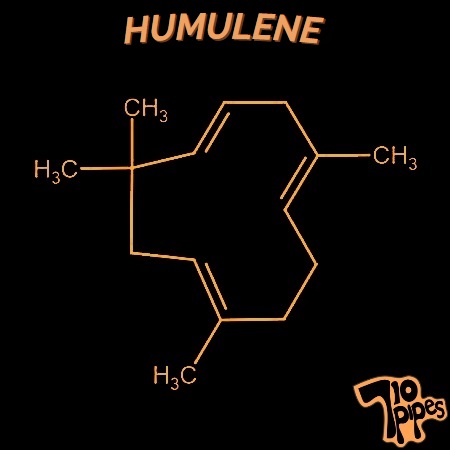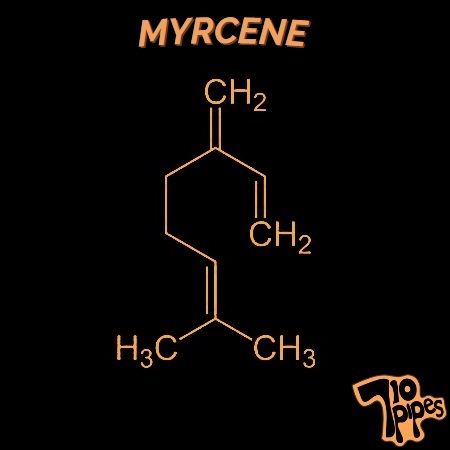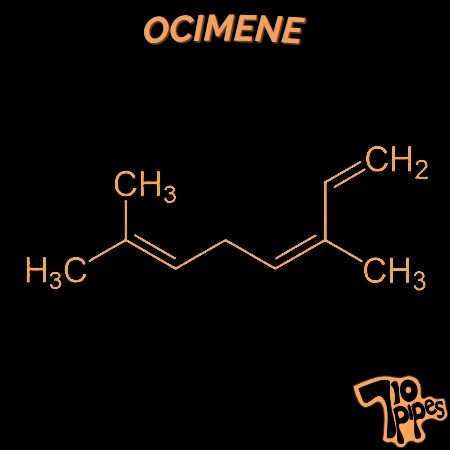Table of Contents
What Are Terpenes?
Terpenes are the oils that dictate the taste, smell and color associated with cannabis and a variety of other plants. Different strains of cannabis contain different terpenes and so have slightly different tastes, smells and appearances. These days, we even have synthetic terpenes and it is often these artificial terpenes that are used to provide vape juice with its particular smell and taste.
Researchers have identified hundreds of different cannabis terpenes. But here’s the thing: terpenes are not the exclusive reserve of the cannabis plant. Every type of plant contains terpenes, which is why different flowers have their own unique scents and different berries their own unique flavor. If you’re clever enough you can combine these myriad different terpenes in countless ways to produce an endless variety of sensory experiences.
Natural Terpenes
In nature, terpenes play several important roles. They can attract pollinators with their appealing scents or help plants defend against herbivores and pathogens. For instance, the distinct smell of pine trees comes from pinene, a terpene that also helps protect the trees from insects.
“In addition to providing an aromatic experience, terpenes are believed to contribute to the effects of cannabis, both alone and in combination with cannabinoids.”
—Laura Tennant, Leafly Science Writer
Beyond their natural roles, terpenes are pretty useful in our everyday lives. They’re key ingredients in perfumes, cosmetics, and food flavorings because of their great aromas. Essential oils, which are rich in terpenes, are popular in aromatherapy and for various wellness practices. You’ll also find terpenes in cleaning products and natural insect repellents.
Plants Containing Natural Terpenes
Synthetic Terpenes
Synthetic terpenes are created in a lab and intended to simulate the flavors and aromas of terpenes created in nature. They are produced through complex chemical manipulation rather than natural processes and for that reason, many people have the same type of trepidation about consuming synthetic terpenes that they have about consuming genetically modified organisms (GMOs). But are those fears well-founded or are they the result of people simply not having enough information?
Think of it this way: when you buy blueberry cheesecake vape juice from a head shop or pipe shop, where do you think that blueberry flavor came from? It came from either esters or terpenes. The esters or terpenes native to the blueberry plant. But, you say, wouldn’t it be a huge pain in the drain to have to extract terpenes from blueberries just to make a batch of vape juice? Yes, it would. So how do they achieve that flavor without the e-liquid costing too much? The answer is synthetic terpenes.
Why Would Vape Manufacturers Use Synthetic Terpenes?
The manufacturing of e-liquids is a business. And if you’ve ever owned a business you know your number one priority is containing costs. Vape juice manufacturers use synthetic terpenes because they’re cheaper than natural terpenes. Using the blueberry cheesecake example we gave above, the cost of extracting natural terpenes from blueberries is prohibitively expensive and would result in the e-liquid costing much more than what it does now.
Natural Terpenes vs. Synthetic Terpenes
Here’s a table comparing various aspects of natural terpenes and synthetic terpenes:
| Aspect | Natural Terpenes | Synthetic Terpenes |
|---|---|---|
| Source | Extracted from plants, flowers, fruits, and herbs | Chemically synthesized in laboratories |
| Purity | May contain impurities from the source plant | Typically high purity due to controlled synthesis |
| Cost | Generally more expensive due to extraction process | Often less expensive due to mass production |
| Complexity | Complex mixtures with multiple terpene types | Can be tailored to specific terpene compositions |
| Sustainability | Dependent on agricultural practices and plant availability | More consistent supply and less dependence on natural resources |
| Aroma and Flavor | Rich, complex, and sometimes variable | Can be designed for consistent aroma and flavor |
Common Terpenes and Their Characteristics
Terpenes are essential compounds found in cannabis and many other plants. They contribute to the aroma, flavor, and overall experience of different strains. Learn more about ten popular terpenes in the following overview.
Bisabolol
Bisabolol is commonly found in chamomile and is widely used in cosmetic products. Its presence in skincare items highlights its popularity in the beauty industry.
- Scent: It has a sweet, floral scent.
- Cannabis Strains Containing Bisabolol: Harle-Tsu, ACDC
- Reported Effects: Bisabolol is noted for its sweet and floral aroma. It is often linked to soothing and comforting effects.
- Other Plants Containing Bisabolol: German Chamomile, Candeia Tree, Myoporum Crassifolium (False Sandalwood)


Caryophyllene
Caryophyllene (otherwise known as “Beta Caryophyllene” or “B-Caryophyllene”) is notable for its wide distribution in culinary spices, as it naturally occurs in many spicy and peppery herbs.
- Scent: It has a spicy, peppery aroma.
- Cannabis Strains Containing Caryophyllene: GSC (Girl Scout Cookies), Bubba Kush, Sour Diesel
- Reported Effects: Caryophyllene is unique among terpenes because it can interact with cannabinoid receptors. It is often associated with a peppery flavor and is believed to contribute to stress relief and relaxation.
- Other Plants Containing Caryophyllene: Black Pepper, Clove, Basil, Oregano
Humulene
Humulene is a prominent terpene in hops, which gives beer its distinct aroma. It is also a significant component in various cannabis strains.
- Scent: It has an earthy, woody scent with subtle spicy notes.
- Cannabis Strains Containing Humulene: White Widow, Headband, GSC
- Reported Effects: Humulene is often noted for its earthy and woody aroma. It is believed to have properties that may suppress appetite.
- Other Plants Containing Humulene: Hops, Sage, Ginseng, Coriander


Limonene
Limonene is widely present in the peels of citrus fruits and is the second most common terpene in cannabis. Its prevalence in citrus fruits makes it a well-known aroma in everyday life.
- Scent: It imparts a strong citrus aroma, reminiscent of lemons and oranges.
- Cannabis Strains Containing Limonene: Super Lemon Haze, Durban Poison, Jack Herer
- Reported Effects: Limonene is known for its uplifting and mood-enhancing qualities. It is often linked to stress relief and a positive mental state.
- Other Plants Containing Limonene: Citrus Fruits (Lemons, Oranges, Limes), Dill, Mint, Juniper
Linalool
Linalool is abundant in flowers and spices, particularly lavender and coriander. It is a common ingredient in many fragrances and personal care products.
- Scent: It offers a floral, lavender-like aroma.
- Cannabis Strains Containing Linalool: Lavender, LA Confidential, Amnesia Haze
- Reported Effects: Linalool is often linked to calming and relaxing effects. It is also noted for its fragrant floral scent, which contributes to the soothing qualities of certain strains.
- Other Plants Containing Linalool: Lavender, Basil, Coriander, Sweet Bay (Laurus nobilis)


Myrcene
Myrcene is one of the most abundant terpenes in cannabis, often being the dominant terpene in various strains. Its widespread presence in cannabis highlights its significant role in the plant’s aromatic profile.
- Scent: It has an earthy, musky scent with hints of cloves, contributing to the distinct aroma of certain cannabis strains.
- Cannabis Strains Containing Myrcene: Blue Dream, OG Kush, Granddaddy Purple
- Reported Effects: Myrcene is often associated with sedative properties and is believed to promote relaxation. It is also thought to enhance the overall effects of THC.
- Other Plants Containing Myrcene: Mango, Hops, Bay Leaves, Lemongrass
Ocimene
Ocimene is commonly found in a variety of plants, such as mint and parsley. Its presence in many culinary and ornamental plants makes it a familiar terpene.
- Scent: It has a sweet, herbal, and woody aroma.
- Cannabis Strains Containing Ocimene: Dutch Treat, Amnesia, Green Crack
- Reported Effects: Ocimene is noted for its sweet and herbal scent. It is often linked to uplifting effects and is thought to contribute to the energetic qualities of certain strains.
- Other Plants Containing Ocimene: Mint, Basil, Mango, Parsley


A-Pinene
Pinene (otherwise known as “Alpha Pinene” or “A-Pinene”) is one of the most prevalent terpenes in nature, especially in pine trees. Its widespread occurrence makes it a well-recognized terpene in both the natural world and various products.
- Scent: It has a distinctive pine scent, evoking the aroma of a forest.
- Cannabis Strains Containing Pinene: Jack Herer, Blue Dream, Strawberry Cough
- Reported Effects: Pinene is associated with alertness and memory retention. It is also believed to have properties that support respiratory function.
- Other Plants Containing Pinene: Pine Trees, Rosemary, Basil, Eucalyptus
Terpineol
Terpineol (otherwise known as “Alpha Terpineol” or A-Terpineol”) is commonly found in lilacs, pine trees, and lime blossoms. It is frequently used in perfumes and cosmetics due to its pleasant aroma.
- Scent: It has a floral, lilac-like aroma with hints of lime.
- Cannabis Strains Containing Terpineol: White Widow, Jack Herer, Girl Scout Cookies
- Reported Effects: Terpineol is often associated with relaxing and calming effects. Its floral aroma contributes to the fragrant qualities of certain cannabis strains.
- Other Plants Containing Terpineol: Pine Oil, Lilacs, Lime Blossoms, Eucalyptus


Terpinolene
Terpinolene – though less common in cannabis – is present in many plants, including apples and lilacs. It is often used in essential oils and fragrances for its complex scent profile.
- Scent: It has a complex aroma with floral, citrus, and herbal notes.
- Cannabis Strains Containing Terpinolene: Jack Herer, Ghost Train Haze, Golden Goat
- Reported Effects: Terpinolene is associated with both uplifting and calming effects. It is often linked to fresh and invigorating scents.
- Other Plants Containing Terpinolene: Apples, Cumin, Tea Tree, Juniper
Understanding the diverse range of terpenes and their characteristics can help consumers choose cannabis strains that best suit their preferences and needs. These aromatic compounds play a crucial role in defining the sensory experience of cannabis.
Browse Our Online Head Shop for Heady Glass, Vape Supplies and More
There is a lot of uncertainty and trepidation surrounding synthetic terpenes but most of it seems like nothing more than media hot air. Still, if you have doubts about using products that contain synthetic terpenes then by all means follow your conscience and avoid them.
And for all your cannabis-related needs make sure to stop by the 710 Pipes online head shop today where you’ll find an astonishing variety of bongs, heady glass, vapes and accessories to suit every need.










1 Comments